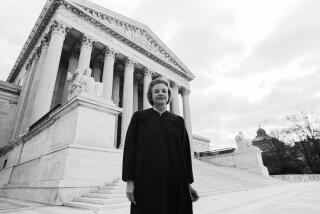Justice Ruth Bader Ginsburg recovering after heart procedure
Justice Ruth Bader Ginsburg, who vowed this year to stay on the Supreme Court as long as she could go “full steam,” announced Wednesday she had undergone a “coronary catheterization procedure” to have a stent put in her right coronary artery.
Ginsburg, 81, was said to be resting comfortably at MedStar Washington Hospital Center and was expected to be discharged within 48 hours.
A statement issued by the court said a “coronary blockage was discovered after Justice Ginsburg experienced discomfort during routine exercise last night.”
Ginsburg is the senior liberal on the closely divided court, and her health and longevity have become a topic of concern on the political left as President Obama heads into the final two years of his term.
Ginsburg was treated for colon cancer in 1999 and pancreatic cancer in 2009, but she bounced back from both and did not miss any time when the court was in session.
A stent is a small mesh tube that can be inserted into an artery through the groin or through the wrist. It is then inflated at the spot of a blockage.
“It restores the blood flow and prevents injury to the heart muscle,” said Dr. Daniel Edmundowicz, chief of cardiology at Temple University Hospital in Philadelphia. “But it would also mean she now has an increased risk for a heart attack down the road.”
Medical experts say stents are an effective and noninvasive means of treating a blockage.
“Somewhere around a million of these procedures are done every year in this country. And experience with the older population is usually quite good,” said Dr. Jeff Brinker, a professor of medicine at Johns Hopkins University in Baltimore.
Ginsburg is at higher risk of heart trouble because of her age, he said.
“This means she has coronary disease,” Brinker said. “There may be other narrowings as well. But she will be put on medicines, and with appropriate treatment, she should do well.”
When President Clinton appointed Ginsburg in 1993, she was the first Democratic nominee to the high court in a quarter of a century.
In recent years, she has rebuffed liberal advocates who said she should retire this year so Obama could fill her seat with another liberal who could win confirmation in a Democratic-controlled Senate. Republicans won control of the Senate in this month’s midterm election, which will make it more difficult for the president to nominate a strong-minded liberal should a vacancy occur in the next two years.
In several interviews, Ginsburg has said she will stay on the court as long as she can do the job. “At my age, we take it year by year,” she said in an interview with Yahoo News, “and I don’t make any predictions about what the future will bring.”
More to Read
Get the L.A. Times Politics newsletter
Deeply reported insights into legislation, politics and policy from Sacramento, Washington and beyond. In your inbox three times per week.
You may occasionally receive promotional content from the Los Angeles Times.






